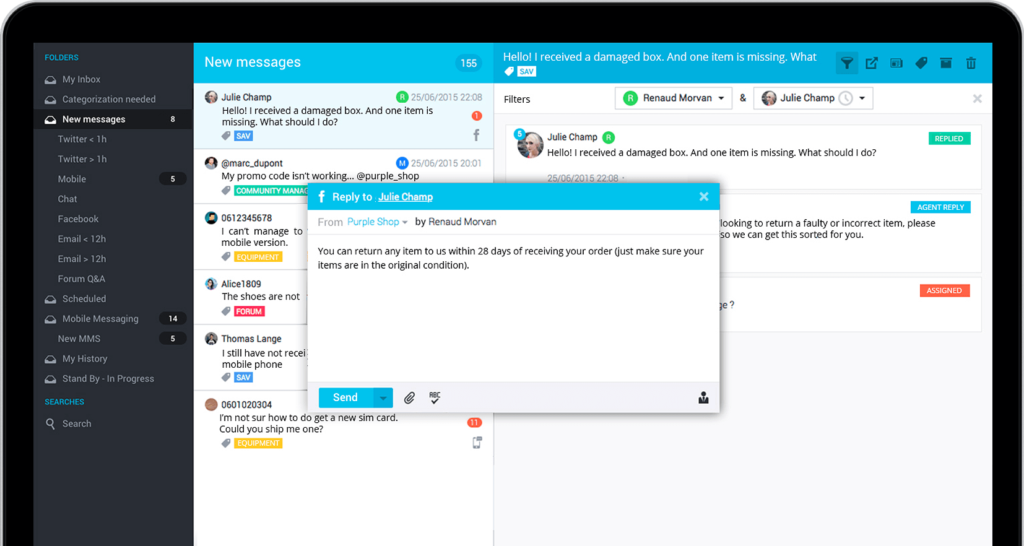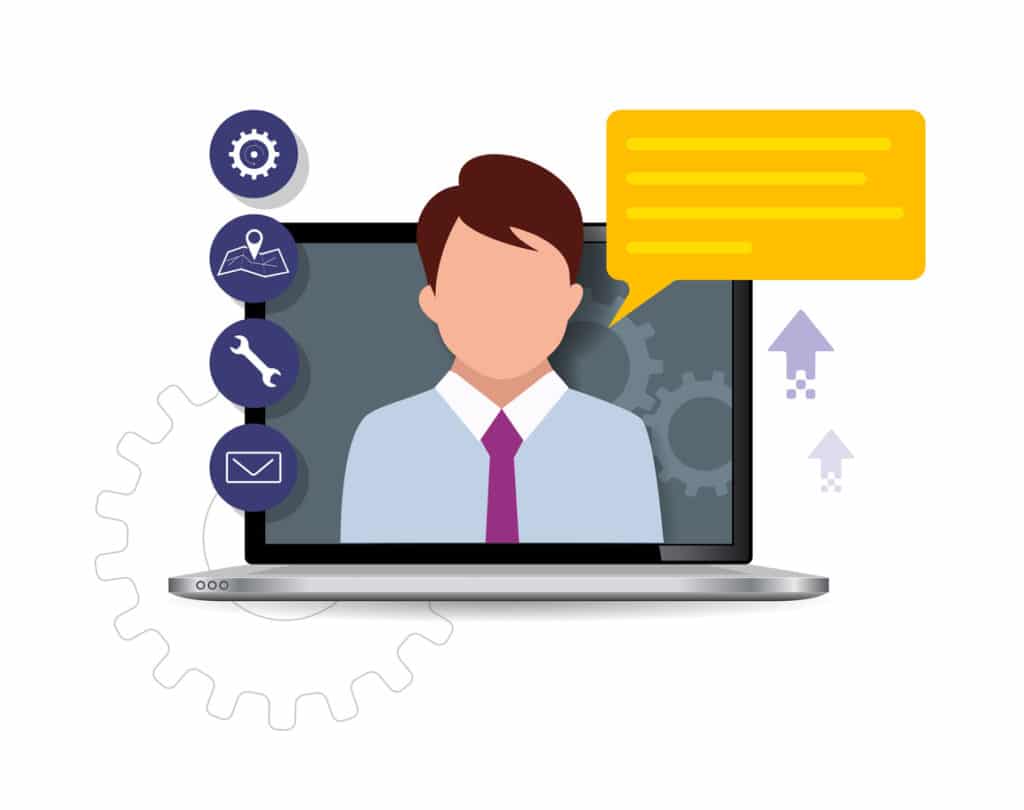Your contact center is on the front lines of your business’ customer service efforts. Since your customer experiences can determine the likelihood of repeat business, you need to develop a contact center with a focus on customer relationship management. High customer satisfaction, however, can only be achieved by first succeeding in several areas of modern contact center management.
How do you manage a contact center’s growth?
Effective contact center management involves balancing and optimizing every process, from end to beginning. As a supervisor, you are responsible for agent performance, contact center software, customer expectations, operations research, and more. Managers make large-scale decisions about contact center technologies and customer data. They are also involved in managing contact center agents, shaping the customer experience, and determining how customers interact with the company. If it affects customer service, it is the manager’s business.
When managed successfully, contact centers see incredible growth, which is good for the business but more stressful for managers. While contact center management isn’t an easy job, there are many processes and resources available to support your work and improve your efforts.

1. Use the right customer service tools
You are only as good as your tools, especially when managing growth in modern contact centers. Whether you’re responsible for inbound and outbound communication or only involved with handling inbound calls, you need contact center technology that helps you reach your goals. Though you need a variety of tools for managing growth in your contact center, every resource depends on one important tool: your contact center platform.
Choosing your contact center software
From traditional call centers to virtual contact centers, the solution you use determines the success of your customer service efforts. There are numerous platforms available, each with its own key features and capabilities, so it’s important to know what you want from your solution. Before you choose your contact center software, make sure you understand which option will best support your growth moving forward.
What is the difference between contact center and call center software?
Comparing call centers vs contact centers is the first step to choosing your solution. The main difference between call centers and contact centers is the channel of communication used when customers engage with the business. Call center software uses only a phone system for customer communication, limiting customer interactions to voice calls. Contact center solutions, however, use multiple channels with both voice and data to connect with customers.
Omnichannel contact centers and call centers have common goals — such as improved customer experiences — but vastly different capabilities. The ability to support multiple channels of communication enables contact centers to meet more customer needs, even over virtual call centers. As customer demands for contact through social media, text messages, email, live chat, and more — along with traditional calls — increase, the advantage is obvious when comparing contact center vs call center software.
When it comes to choosing contact center solutions, however, phone calls vs omnichannel capabilities aren’t the only concerns.
Cloud contact center vs on-premise contact center solutions
No matter how many capabilities you want, contact center managers also have to decide between on-premise and cloud platforms.
On-premise solutions, also known as legacy center solutions, are physical systems and software that are installed at the business’ office. These systems require high financial investments in both hardware and software, as well as installation costs (OPEX). The business handles all maintenance and growth needs, adding and adjusting hardware as needed. Most of the time, adding new capabilities or lines also requires significant time and financial investments. Your contact center’s uptime depends on your ability to keep your system running smoothly and effectively, increasing the stress of your work.
When running a cloud contact center, on the other hand, your business uses hosted contact center software to connect with customers. Your outsourced contact center solution is managed and maintained by your provider, reducing costs and responsibilities. These systems offer increased flexibility, allowing you to adjust your capabilities and scale as needed. Cloud computing also enables unified communications, allowing real-time access to your center’s agents, data, and system from any place, at any time.
Whether you manage call center agents or an omnichannel contact center, using a cloud-based platform is your best solution for growth management.

2. Create the ultimate customer experience
Today, the contact center experience is more important than ever. In a study by American Express, 33% of Americans said a single bad customer service experience would cause them to consider switching to a competitor. A study by Motista also found that customers who have developed an emotional relationship with a company have a lifetime value that is 306% higher than customers who aren’t emotionally attached.
These numbers are just a taste of current customer service demands. Providing an acceptable solution to a problem is no longer enough. Instead, businesses need to meet customers on the channel they prefer and resolve their problems within minutes to create a positive customer experience. Agents play an important role in customer interactions, but the ultimate customer experience relies on your contact center solution’s ability to meet customer expectations.
Minimize call wait times
When connecting with a business, specifically when using a phone channel, customers want quick service. To minimize call waiting time, no matter your call volumes, you need to utilize tools that streamline your processes. Interactive voice response systems, for instance, use automated messages to reduce the number of callers with frequently asked questions that don’t require human interaction. Queue management capabilities also limit the amount of time your customers spend on hold. By giving callers the option to choose an automatic call-back rather than waiting on hold, you can show that you value their time and are working hard to meet their needs.
Increase first-contact resolution
Few things damage customer satisfaction more than the need to contact a company numerous times for a single problem. Cloud-based contact centers help increase first-contact resolution by giving agents access to effective solutions on a shared knowledge base. Cloud solutions allow agents to serve customers better, but they also improve customer satisfaction if the first solution fails. By integrating your CRM system directly with your contact center solution, your agents gain instant access to customer information with every customer contact, allowing them to understand the situation without further questioning. Without the need to repeat the same questions and waste more of the customer’s time, your agents can stop interactions from escalating and help keep customers happy.
Streamline customer interactions
Every time a customer types into a chat box or sends an email, your processes determine the success or failure of the interaction. To keep both customers and agents happy, build processes that are easy to follow and designed to move quickly. For both a contact center and call center, for example, interactive voice response systems reduce wait and call times. These systems make sure callers connect to the right department while gathering relevant data in the process. If the caller can’t find a solution in the automated responses, your live agents can then use this information to understand and resolve the problem quickly.
Connecting customers to the right agent is also important for a smooth interaction. A tool like an automatic call distributor uses customer profiling to determine which agent can most effectively resolve the customer’s problem. When your agents are best equipped to handle the calls they receive, their higher workplace happiness can lead to an improved customer experience.

3. Optimize your workforce
Your agents are the lifeblood of your contact center. Your results depend on the success of your customer service and your customer service depends on the outcome of every interaction your agents have with customers. When managing growth in your contact center, you are responsible for creating and maintaining a happy and effective workforce. This starts with hiring the right people and continues when you create a great place to work. When a contact center agent is satisfied in their job, this positivity naturally leads to better work and higher customer satisfaction.
Hire the best center agents
Hiring success requires finding someone who will excel in the job and remain in the position in the long-term. In a study by TLNT.com, research found that replacing an employee in an entry-level job costs the company between 30-50% of the position’s annual salary. Rather than spending time and money on high employee turnover, focus on finding applicants with the skills, personality, and work ethic to become long-term assets to your team. Stay transparent and honest about your business and positions to attract the high-quality candidates you need.
Design an effective onboarding process
The best long-term contact center agent relationships begin with a solid onboarding process. These positions come with a lot of responsibility, so it’s vital to equip your agents for success from the start. Pair new hires with your top agents to help them learn best practices. Use a combination of incentives, simulations, and interactive activities to appeal to every learning style. Walk through every step of their work, from customer interactions to software use, during training to encourage confidence and proficiency. Empower your agents by listening to their needs and helping them become the best agents they can be.
Develop flexible agent training processes
Flexibility is a key feature for any contact center solution, but it’s also critical for your agent training procedures. As customer demands and contact center needs change, your agent education needs the ability to adapt as well. Keeping your employees aware and equipped for these changes enables their success and avoids frustrations that can limit productivity. Help agents stay up-to-date by offering training videos, articles, and classes that cover current and new topics. Develop adaptable training processes that maintain agent capability and power through any development.
Scripting can be a powerful tool to help with your agents on-boarding and continuous training. A good scripting tool will be easy for the Administrator to keep up to date with the needs of the company (new products, new offering, etc), it will be open so that customer specific information can be automatically retrieved when talking to the customers, to achieve a more personalized interaction, and it will be intuitive to use for the agent, like a workflow, easily guiding the agent during the conversation with the customer.
Improve workforce management
Efficient scheduling improves your contact center’s ability to manage high call volumes and avoids agent burnout. With a contact center solution that offers workforce management tools, you can create schedules that meet both your needs and your agents’. By planning your schedules around peak times, you can ensure adequate response times without overwhelming the agents on the floor. This allows you to avoid unnecessary agent downtime and any costs that come with it.
Workforce management also allows you to carefully monitor performance and quality management. You can build a work atmosphere that remains sensitive to employee needs without sacrificing results. Your supervisors can offer improved leadership to help agents produce even better results.
RingCentral Collaborative Contact Center

4. Develop a customer-centric, agent-friendly environment
Unhappy agents lead to poor interactions and dissatisfied customers. Your contact center model should include a balanced focus on both customer happiness and agent satisfaction. To encourage growth in your contact center, you need a team that is dedicated to your goals and willing to work to achieve them. Success is the greatest motivator and, since you’re working toward excellent customer satisfaction, positive results will naturally lead to a more positive environment overall.
Enable team collaboration
Maintaining high customer satisfaction is a team effort. Your contact center agents need the ability to communicate seamlessly with each other, both during downtime and in the middle of a customer interaction.
Support this collaboration by offering communication resources that encourage productive interactions, such as an internal messaging tool. Streamlining employee communication and engagement ensures effective teamwork in times of stress and crisis. The more employees are used to reaching out for help and support, the better their results will be.
Maintain agent coaching and support
Though agents may not need additional coaching or assistance once they’ve finished your training program, agent coaching is a valuable resource for your contact center. Gallup research, for example, found that 67% of employees who had their strengths emphasized by managers were completely engaged in their jobs. When managers focused on employee weaknesses, however, only 31% were found to be engaged with their work.
Using a cloud-based contact center platform that offers agent coaching tools can revolutionize your productivity. With a tool like Whisper Coaching, supervisors can join an interaction and provide hidden guidance to the agent in real-time. If the interaction escalates, the supervisor can seamlessly take over. Call recording tools can also benefit your agents. Supervisors can use previous calls to determine areas that need improvement, giving agents specific ways to improve their interactions.
This minimizes agent stress and frustration while ensuring customers receive the best service, even when they’re being difficult. It also shows the value you place on your agents, giving them another reason to love their place of work.
Improve customer journey management
Happy, engaged agents will always be better equipped to improve every customer story. As they maintain positive interactions with every call, social media post, or text, they can effectively move customers through your sales cycles. Equipping your contact center with software that offers a comprehensive customer history further supports their efforts. You’ll enjoy improved customer satisfaction, increased sales, and higher revenue, prompting even greater growth and results.

5. Monitor contact center compliance
In every industry, both call centers and contact centers have to follow strict state, federal, and local laws. While managing your contact center’s growth, compliance is one of your most important responsibilities. Your contact center software may support compliance, but you are the only person who can ensure your employees and practices fall within acceptable guidelines.
Protect customer data
Customer service requires the exchange of personal data, though some information is less sensitive than others. For some businesses, agents may only handle information such as names, addresses, and credit card details. If your contact center operates in finance, healthcare, or another sensitive field, however, your system’s security is a top priority.
To give your customers peace of mind about their data, carefully monitor your software’s encryptions and security. Track and limit access to sensitive information. Use strict policies to protect your customers from exposure and fraud. Show customers that you prioritize their safety and data privacy above all else.
Avoid contact center violations
For total compliance, you also need to maintain acceptable communication practices. When making an outbound call to a potential customer, for example, your agents should never be dialing a number on the National Do Not Call (DNC) list. Failure to follow DNC restrictions can expose your company to fines and penalties, costly consequences that can stunt your contact center’s growth.
As a manager, you are responsible to know and understand the laws and rules that govern your contact center. To avoid any possibility of non-compliance, consult an attorney or your company’s legal team for guidance specific to your industry and contact center.

6. Keep future contact center growth in mind
Growth alone isn’t enough to ensure contact center success. Instead, you also need to consider and plan for the future of your customer service efforts. Customer demands continue to change and grow at an incredible pace, which limits your ability to fully predict future needs. Though you can’t know exactly what customer service and the customer experience will look like in the coming years, you can use your resources to prepare your contact center for what’s to come.
Keep contact center technology up-to-date
No matter which ways the customer service industry changes, you will always rely on your software solution to keep up. What started with simple computer telephony integration has now evolved to include artificial-intelligence-driven automation and real-time connections. As technology continues to advance and customer demands change with it, your contact center must remain current.
Maintain control of your software
When you don’t have control over your contact center solution, you face an increased risk of falling behind industry trends. To keep your contact center reactive and adaptive, choose a solution that is cloud-based and offers open APIs. The ability to customize your software to meet your needs can revolutionize your use. When you can integrate your solution with a partner network and use it to improve your customer experience, for example, you can achieve much higher customer satisfaction.
Enjoy seamless scalability
You never know what your customer service volumes will look like in the future, which makes contact center scalability invaluable. The elasticity of cloud-based platforms allow you to adjust the number of agent seats in just moments, helping you stay prepared for any need. Eliminating the need for extensive additional hardware for each new seat also drastically reduces costs. This flexibility allows you to optimize your workforce and avoid overworking your agents. As automation advances, creating the potential for extensive workforce changes in the future, your contact center platform will keep you ready for any changes.
Managing growth in your contact center is a full-time job. Give yourself and your agents the resources you need to continue expanding and thriving with our omnichannel, cloud-based contact center solution. Explore our features for yourself or contact us for a personalized demo today.
Originally published Mar 31, 2020, updated Jul 25, 2024





